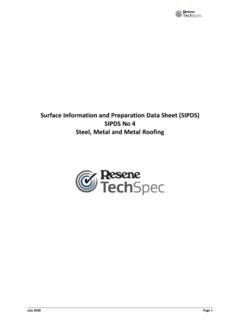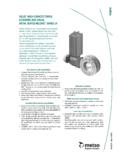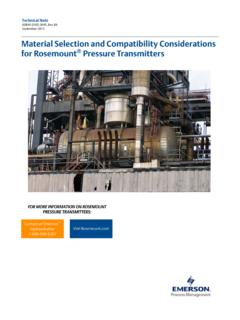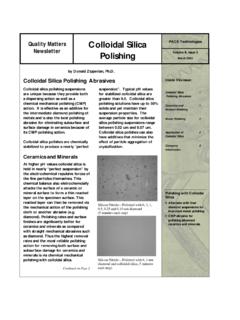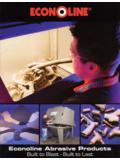Transcription of BLASTING TECHNICAL INFORMATION - …
1 BLAST FINISHINGB lasting is the process where small angular or spherical particles are propelled at a part by compressed air, or mechanical high speed rotating wheels or water pumps .The blast media type, shape, size, density, and hardness, along with media acceleration and volume of media, combined with BLASTING distance from the workpiece, angle of impact and time cycles are important factors in the blast process capabilities. The BLASTING equipment is produced to deliver, reclaim and contain the media, contain the part to be blasted and collect the dust from the BLASTING process. Parts can be processed individually as a batch process or can be automated thru the affects from the BLASTING process are: VISUAL MECHANICAL Bright Matte finish Deburring Dull Matte Finish De-flashing Satin finish Paint and coating removal Satin luster finish Peening Blending of tool marks Pre paint and coating adhesion Removal of weld discoloration Heat treat, mill scale removal Surface cleaning Weld splatter removal Glass frosting and etching Thermal metal spray prep.
2 Pre plate and anodize finishes Rust removal Mold cleaning BLASTING TECHNICAL INFORMATIONFACTORS THAT AFFECT BLAST FINISHING delivery containment enclosures, media recovery and dust collection used in industrial BLASTING DELIVERY SYSTEMST here are three media delivery systems that propel and deliver media for high speed impact to the part being BLASTING ( Pneumatic) Wheel (airless BLASTING ) BLASTING (pumped water)A. AIR BLASTING utilizes an air compressors energy to deliver air/media mix at speeds and volumes to impact the parts being air speed or pressure of an air compressor is controlled by a pressure regulator. The regulator can increase or decrease the speed of the media delivery.
3 Air pressure is measured by pounds per square inch (psi), industrial BLASTING is effectively done between 20 and 90 PSI. The higher the PSI the higher the air volume delivered of the air/media mix is determined by the orifice or opening diameter of the nozzle with pressure blast systems or air jet diameter of the suction blast gun body. Air volumes are measured by surface cubic feet per minute (scfm).The larger the orifice ID opening the larger volume of air/media. Other factors that affect volume of air into the blast system is media and air hose diameter. Increased air pressure (PSI) also increases the SCFM with a given size orifice.. Industrial BLASTING gun bodies of suction cabinet blast systems range between 12 to 38 SCFM. The pressure blast cabinet systems range between 12 to 68 scfm and the pressure blast room systems use up to 254 air compressors produce approximately SCFM per horse power (hp).
4 BLASTING cabinets require 3 to15 hp compressors per nozzle and blast rooms can use up to 53 per man or TECHNICAL INFORMATIONTHERE ARE TWO TYPES OF AIR BLAST DELIVERY SYSTEMSS uction ( used in blast cabinets)Pressure ( used in blast cabinets, blast rooms, and outdoor BLASTING )SUCTION BLASTING uses the venture principle sucking media from a hopper. The air jet is 1/2 the ID of the nozzle and as the air stream is passed through both, it creates a low pressure which sucks the media from the hopper into the air stream. The media acceleration distance is very short ( from the nozzle to the workpiece-approximately 4 to 14 ). The suction systems work fine and can be continuously blasted as long as there is BLASTING media in the systems do not deliver media well at very low air pressures (5 to 25 psi) and they have limits on how long the suction feed hose can be. Very heavy BLASTING ( larger steel media) cannot be conveyed into the air stream with suction BLASTING .
5 Most industrial blast cabinets are suction systems and work well with most BLASTING utilizes various sizes of ASME approved pressure vessels called pressure pots. The pressure pot contains the media, and as it is energized with compressed air, it pressurizes the pot. When the air/media mix is released from the pot it accelerates from the pot through at least 5-10 feet of hose and then even faster as it travels thru the ventura of the nozzle. The acceleration rates of air/media mix are much higher in pressure BLASTING than suction BLASTING . When the pressure pot empties of the media and air, the pressure pot has to be depressurized to refill the pot with media. The pressure BLASTING systems are much more productive when BLASTING than suction systems. Pressure systems can blast all medias regardless of weight or size and can also deliver medias at very low TECHNICAL INFORMATIONAIR BLAST SYSTEMS - AIR CONSUMPTION RATESB elow are charts of air volume (SCFM) used in BLASTING with pressure and suction systems utilizing various pressures (PSI) and orifice BLAST SYSTEMS - AIR REQUIREMENTS Suction Systems Pressure Systems Suction-Blast Air Requirements (scfm) Pressure-Blast air requirements (scfm)Pressure (psi) 30 40 50 60 70 80 90 100 Pressure (psi)
6 20 30 40 50 60 80 100 1201/4 nozzle 3/32 jet 6 7 8 10 11 12 13 15 1/8 nozzle 6 8 10 13 14 17 20 251/4 nozzle 1/8 jet 10 12 15 17 19 21 23 26 3/16 nozzle 15 18 22 26 30 48 45 555/16 nozz 5/32jet 15 19 23 27 31 37 38 42 1/4 nozzle 27 32 41 49 55 68 81 977/16 nozz 7/32 jet 31 38 45 52 59 66 73 80 5/16 nozzle 42 50 64 78 88 113 137 152 3/8 nozzle 55 73 91 109 126 161 196 220 BLAST ROOMS AND OUTDOOR SYSTEMS - AIR REQUIREMENTSAir consumption and media delivery rates are much higher on blast rooms and outdoor BLASTING systems than in pressure blast cabinets.
7 The air supply hose ID, the media blast hose ID, the nozzle ID, the pressure pot and pot piping are all much larger on the blast rooms than cabinet systems. The increase in production is also due to the further distance that the nozzle is from the work piece in blast rooms creating a larger blast blast requirements (blast rooms)Nozzle ID Pressure 60 70 80 90 100 120 3/16 AIR (CFM) 30 33 38 41 45 #3 Air compressor horse power 7 8 10 Lbs Sand hour 171 196 216 238 264 1/4 Air (CFM) 54 61 68 74 81 97 #4 Air compressor horse power 12 15 18 Lbs Sand hour 312 354 406 448 494 582 5/16 Air (CFM) 89 101 113 126 137 152 #5 Air compressor horse power TECHNICAL INFORMATION Lbs Sand hour 534 604 672 740 812 912 3/8 Air (CFM)
8 126 143 161 173 196 220 #6 Air compressor horse power Lbs Sand hour 754 864 960 1,052 1,152 1,320 Nozzle ID Pressure 60 70 80 90 100 120 7/16 Air (CFM) 170 194 217 240 254 300 #7 Air compressor horse power Lbs Sand hour 1,032 1,176 1,312 1,448 1,584 1,800 1/2 Air (CFM) 224 252 280 390 338 392 #8 Air compressor horse power Lbs Sand hour 1,336 1,512 1,680 1,856 2,024 2,352 AIR BLAST PRODUCTION RATESB last nozzle spray patterns are affected by orifice size, air pressure, and distancefrom the total diameter of the blast pattern increases as the distance from the workpieceis increased.
9 The hot spot (where work speed is maximized) can be obtained at larger distances from the workpiece with pressure air blast SUCTION BLASTING CABINET PRESSURE BLASTINGBLASTING TECHNICAL INFORMATIONCABINET BLAST PRODUCTION RATESB elow is an estimate of abrasive delivery rates per hour and sq. ft. of blast area insq. ft. per minute with various orifice s and 80 CFM PSI Blast Area abrasive Unit Hr. 3/32 7 80 1/2 80 lbs 1/8 15 80 1 to 1-1/2 120 lbs 5/32 25 80 1 to 2-1/2 160 lbs 3/16 40 80 3 to 3-1/2 216 lbs 1/4 80 80 4 to 4-1/2 400 lbsBLAST ROOM AND OUTDOOR BLAST PRODUCTION RATESBLAST SPECIFICATIONS ESTIMATED BLAST CLEANING RATESNO 1 WHITE METAL BLAST SSPC-SP5 #7 NOZZLEA pprox.
10 Sq. Ft. Cleaning Per Hour Loose Mill Scale 170 Sq. Ft Tight Mill Scale 140 Sq. 90 PSI Pitted Paint 85 Sq. Ft. Layered Paint 70 Sq. 2 NEAR WHITE BLAST SSPC-SP10 #7 NOZZLEA pprox. Sq. Ft. Cleaning Per Hour Loose Mill Scale 180 Sq. Ft. Tight Mill Scale 146 Sq. 90 PSI Pitted Paint 90 Sq. Ft. Layered Paint 72 Sq. 3 COMMERCIAL BLAST SSPC-SP6 #7 NOZZLEA pprox. Sq. Ft. Cleaning Per Hour Loose Mill Scale 420 Sq. Ft. Tight Mill Scale 270 Sq. 90 PSI Pitted Paint 200 Sq.


